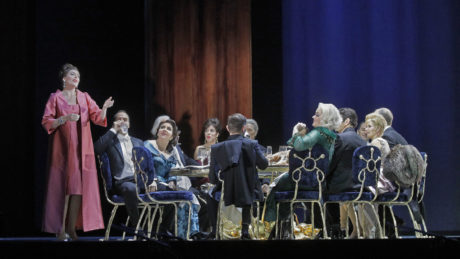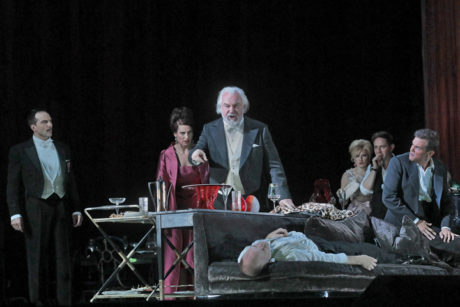Metropolitan Opera audiences, paying up to $393 for a ticket, can relate to the wealthy party guests in The Exterminating Angel. And so do some prestigious critics, who called this “the one opera to see this season.”
Don’t they realize that they are being excoriated in this absurdist production? Don’t they see that the joke is on them?
The opera is a gigantic trick on the audience, as created by composer/librettist Thomas Adès and his co-librettist Tom Cairns, who also directed. They based their piece on Luis Buñuel’s 1962 film with the same title, where guests are in an opulent mansion and are mysteriously incapable of leaving. Buñuel refused to disclose his film’s meaning, but it was accepted as a denunciation of decadent life in Franco’s Spain. Perhaps the guests represent the ruling class, increasingly resentful at being shut off from the world outside.

We are reminded of Jean-Paul Sartre’s No Exit, and of Anne Meara’s After-Play. In both of those dramas the characters are dead although they don’t know it. But in The Exterminating Angel they are not – until one by one they begin to perish.
Humor is obviously intentional; musical puns abound (the melody of Bach’s “Sheep May Safely Graze” accompanies the appearance of live sheep at the mansion, to cite just one example). Beyond that, it seems as if Adès and Cairns are pulling our legs, and some viewers are interpreting the opera as profundity. Actually, there is a serious statement contained within the nonsense: These supercilious patricians are hollow people who lack the initiative and the resolve to move forward – out through the open doors – and, instead, revert to uncivilized behavior like smashing their walls and pipes in search of water, and roasting their pet sheep for dinner.
Adès’s music is his most accomplished to date. I enjoyed his Powder Her Face, which amusingly told a scandalous story among England’s upper crust, and I was annoyed by his version of The Tempest because it was all sound and fury and drained the charm from Shakespeare’s romance (when the Met’s website boasts of “the rapturous response” to Ades’s previous opera, that’s sales promotion).
The score for The Exterminating Angel is subtler and more varied than either of those two. The Ondes Martenot — an eerie-sounding electronic instrument — plays a prominent part, suggesting the mysterious force that keeps the socialites in the room, and a brilliantly percussive march (similar to Shostakovich in The Nose) bridges the two scenes of the first half. On the other hand, much of the vocal writing is high-pitched declamation, and two of the sopranos are given notes so high that they come out as squeaks.

Sections of dialogue and music are intentionally repeated for no apparent reason while the Met’s chandeliers retract to the ceiling, then drop back down and rise all over again. I admire the composer’s cleverness in displaying a wide palette of colors.
The opera doesn’t have “lead” roles. Instead, there’s a relatively even assignment amongst the large cast which includes Christian Van Horn, Joseph Kaiser, Amanda Echalaz, Alice Coote, Sophie Bevan, David Portillo, Sally Matthews, Iestyn Davies and Kevin Burdette. Audrey Luna deserves praise for emitting her stratospheric notes, but her best moment is a medieval Ladino song by the Spanish Jewish philosopher Yehuda Halevi, expressing longing for a lost homeland. Mezzo Christine Rice sings a lovely song while accompanying herself on the piano. Veteran bass John Tomlinson provides gravity as a doctor who tries to maintain calm. Hildegard Bechtler’s set and costumes are attractive.
The Exterminating Angel ultimately disappoints because, unlike truly great operas, it doesn’t touch us or move us like Wozzeck and Peter Grimes from the 20th century and Silent Night and Written on Skin from our own. The Exterminating Angel is as superficial as its characters.
Gary Halvorson did his usual superb job of directing for live television. He uses more long shots than usual, to reveal the full stage and the rising and descending of the Met’s chandeliers. The telecasts are beamed to 2,000 theaters in 73 countries. It will also be broadcast in HD to movie theaters on November 29, 2017.
Running Time: Two hours and 40 minutes, with one intermission.

The Exterminating Angel played through Tuesday, November 21, 2017, at the Metropolitan Opera – 30 Lincoln Center Plaza, NYC.





When I went to see the opera in its HD broadcast to movie theaters, I was impressed by the design of the production and the orchestral writing, but found the vocal writing to be excruciating, humiliating for the large cast of fine singers and ultimately offensive. And my movie-theater ticket only cost about $30. What must those actually present at Lincoln Center have thought of being duped out of much larger costs of admission?? My first impulse was to write a scathing blog or Facebook post about the hubris of a composer taking the enormous resources of the Met and allowing them to spend that money in support of an opera as annoying and anti-singer as this one. But as December progressed I decided instead to make my public response to it a musical one, as linked below:
https://morricone1900.livejournal.com/127747.html